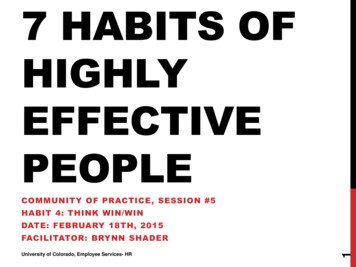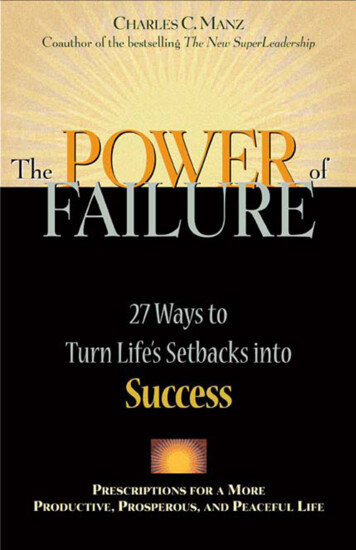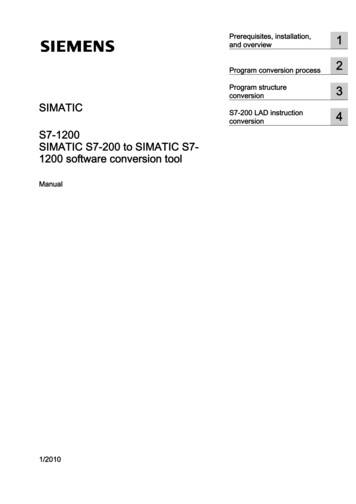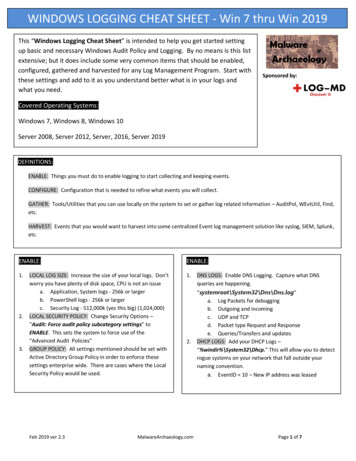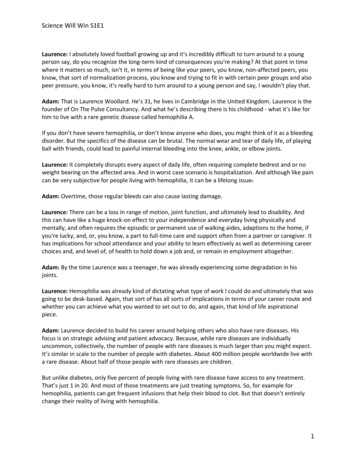
Transcription
Science Will Win S1E1Laurence: I absolutely loved football growing up and it's incredibly difficult to turn around to a youngperson say, do you recognize the long-term kind of consequences you're making? At that point in timewhere it matters so much, isn't it, in terms of being like your peers, you know, non-affected peers, youknow, that sort of normalization process, you know and trying to fit in with certain peer groups and alsopeer pressure, you know, it's really hard to turn around to a young person and say, I wouldn't play that.Adam: That is Laurence Woollard. He’s 31, he lives in Cambridge in the United Kingdom. Laurence is thefounder of On The Pulse Consultancy. And what he’s describing there is his childhood - what it’s like forhim to live with a rare genetic disease called hemophilia A.If you don’t have severe hemophilia, or don’t know anyone who does, you might think of it as a bleedingdisorder. But the specifics of the disease can be brutal. The normal wear and tear of daily life, of playingball with friends, could lead to painful internal bleeding into the knee, ankle, or elbow joints.Laurence: It completely disrupts every aspect of daily life, often requiring complete bedrest and or noweight bearing on the affected area. And in worst case scenario is hospitalization. And although like paincan be very subjective for people living with hemophilia, it can be a lifelong issue.Adam: Overtime, those regular bleeds can also cause lasting damage.Laurence: There can be a loss in range of motion, joint function, and ultimately lead to disability. Andthis can have like a huge knock-on effect to your independence and everyday living physically andmentally, and often requires the episodic or permanent use of walking aides, adaptions to the home, ifyou're lucky, and, or, you know, a part to full-time care and support often from a partner or caregiver. Ithas implications for school attendance and your ability to learn effectively as well as determining careerchoices and, and level of, of health to hold down a job and, or remain in employment altogether.Adam: By the time Laurence was a teenager, he was already experiencing some degradation in hisjoints.Laurence: Hemophilia was already kind of dictating what type of work I could do and ultimately that wasgoing to be desk-based. Again, that sort of has all sorts of implications in terms of your career route andwhether you can achieve what you wanted to set out to do, and again, that kind of life aspirationalpiece.Adam: Laurence decided to build his career around helping others who also have rare diseases. Hisfocus is on strategic advising and patient advocacy. Because, while rare diseases are individuallyuncommon, collectively, the number of people with rare diseases is much larger than you might expect.It’s similar in scale to the number of people with diabetes. About 400 million people worldwide live witha rare disease. About half of those people with rare diseases are children.But unlike diabetes, only five percent of people living with rare disease have access to any treatment.That’s just 1 in 20. And most of those treatments are just treating symptoms. So, for example forhemophilia, patients can get frequent infusions that help their blood to clot. But that doesn’t entirelychange their reality of living with hemophilia.1
Science Will Win S1E1What would life be like if there was another option? A potentially one-time treatment that could get atthe root cause of a rare disease? Well, it may be possible and research is currently ongoing.Welcome to Science Will Win. I’m Adam Rutherford.I’m a geneticist, and science communicator. I’ve spent my life studying Darwin and evolution, syntheticbiology, and developmental genetics. I’ve even served as a science consultant for films such as ExMachina and Annihilation.And in this season of Science Will Win we’re going to be exploring gene therapy.Now I first learnt about gene therapy as an undergraduate studying genetics in the 1990s. We were onlya few years after the first disease genes had been identified, things like Duchenne Muscular Dystrophyand Cystic Fibrosis. And the prospect then for treating and correcting those diseases made it all veryexciting. But this was years before the Human Genome Project and the complexities of genetics wouldbe fully realized. In retrospect, that enthusiasm was perhaps a bit naïve.Over the course of the season we’re going to be following the long journey gene therapy has taken. Andwe’ll explore the complex path these medicines are still traveling in the hope of becoming availabletreatments. We’re going to be talking to scientists, advocates, policymakers, and crucially to patients,and their loved ones, to get the full scope of where we’re going - and why it’s so important that we getthere.And just as a reminder, Gene Therapy is a promising area but it is investigational in nature for manydiseases. There is so much research to be done to understand the safety and efficacy of those potentialtherapies. Remember, you should always discuss treatment options with your healthcare provider.Dirk: I always tell to my friends or my family members that I'm witnessing, some exceptional momentsin, in medicine and in science, and I feel extremely privileged and lucky to be able to witness them.My name is Dirk, Dirk Vander Mijnsbrugge, which for you is probably a name that is very difficult if notimpossible to pronounce.Adam: Dirk is a vice president of medical affairs at Pfizer. He’s a medical doctor by training.Dirk: I graduated medical school end of the eighties. So more than 30 years ago. And I worked as a GP,and at that time the therapeutic armamentarium that we had, like the medicines we had, were what wecall in technical terms, small molecules, right. they are, and they were very effective medicines. So forexample, anti-hypertensive medicines right people with hypertension, we had very good antihypertensive medicines and what these medicines did, they treated symptoms of high blood pressure,and really they help patients. But these were medications that had to be taken daily, chronically.Adam: And that’s the case for a lot of medicines throughout history. If you have an illness, you takesomething that treats those symptoms. And that can work very well. But, they’re not treating the causeof the illness.More than three decades ago – when I was starting out in genetics - gene therapy was just an idea; aconcept that DNA might be used as medicine and help us do just that: treat the cause of a disease.2
Science Will Win S1E1But scientists latched onto that idea and turned a speculation into reality.By the mid 90s, Dirk had started working in the pharmaceutical industry. And it was around that timethat things started to really change.Dirk: At that time, I witnessed what was really a revolution in medicine and in science. And it was theavailability of what we call disease modifying agents. Now with these disease modifying agents, wecould have medicines that could influence the course of the disease. But here again, these medicineshad to be taken lifelong.Adam: This next generation of disease modifying agents are sort of like a precursor to gene therapy.They do what their name says: they modify a disease rather than treating symptoms. What you’re tryingto do here is change the nature of the illness. Still, they need to be taken indefinitely to keep working.This was also an important moment for Sonal Bhatia, chief medical officer for rare disease at Pfizer. Shestarted her career as a physician, too. Seeing this shift to modifying diseases and treating them at theirsource really changed things for her.Sonal: It made me realize that if I could move to the world of pharma, I could make a difference inbringing breakthrough medicines. As the chief medical officer, in my role, I am responsible for helpingnavigate a group of people that are working with our clinical team and our commercial team to helpbring very important medicines through the fruition and completion of our phase three trials, and thentaking them through the regulatory approval to finally have access of our medicines to patients.Adam: Now this is a key point: Two things make gene therapy fundamentally different from othertreatments: the first, is that gene therapy addresses the root cause of genetic disease. And second, it ispotentially a one-time treatment that doesn’t need to be administered continually for the rest of theperson’s life.Now these are fundamental ideas at the center of gene therapy, so let’s get stuck into the weeds here.What is the root cause of a genetic disease?Now, cast your mind back to science class, where you learn about DNA and genes. Genes are made ofDNA, and we humans, we have about 20,000 genes in every cell. Genes are bits of code that influence allsorts of physical characteristics, from simple things like hair color or eye color, all the way up toimmensely complicated things like behavior. And they can do that because genes encode proteins, andproteins, well they do all the work in an organism – all life is either built of – or by – proteins. But wehave to zoom in a little bit further, because what DNA actually does is encode amino acids, and proteinsare made of amino acids. Cells are industrious little factories, as Dirk explains.Dirk: And what this factory does, the factory produces proteins and those proteins allow for the normalfunctioning of the organ and of the body right. Now, what happens if one of these genes is notfunctioning properly? So either the gene does not function at all, meaning that the factory does notproduce the necessary proteins, or the genes produce the wrong proteins.3
Science Will Win S1E1Adam: In some cases, that malfunctioning leads to rare genetic diseases -- like hemophilia. Inhemophilia, the deficient or defective gene doesn’t produce a clotting protein, which is needed to helpthe blood clot and prevent bleeding. But that’s just one example. There are about 7,000 rare diseasesand 80 percent of them are genetic in origin. Throughout the series, we’ll hear more about a few ofthem.It’s kind of terrible that such a small part of your body – one gene - can have such an impact oneverything in your life.But, that’s also what makes it a prime place to start for gene therapy. Here’s Sonal again.Sonal: So when you just have one gene that's altered, it is easier to think about, well, what is that gene,put it into the vector, put it into the human body and have it target the organ and replace that singlegene. An example of that is hemophilia A, hemophilia B, Duchenne muscular dystrophy. These are allexamples of single gene alteration diseases. And it becomes an easier proposition for gene therapy toreprogram cells at that with just one gene alteration so that they can function normally.Adam: There are three general methods for gene therapy and they are all pretty astonishing methods oftrying to correct faulty genes.The first one is called gene silencing. It kind of works like this: we pinpoint the gene that’s not workingcorrectly. And then, we aim to go into that genetic code and basically tell it to stop. Dial it right down.Silence it.Another approach is called gene editing. You use an editing technique such as CRISPR, you can go in andpermanently cut and paste the genetic code, or replace or repair that malfunctioning gene.But the method we’re going to be focusing on here is called gene transfer. Doctors would inject aworking gene into the body’s cells. That gene will then potentially start producing the correct proteinsand take over from the faulty gene. That sounds super easy, but how does that actually happen?Dirk: Now here is where science-fiction comes to place that's. We have the gene, so how do we get thegene into the body? How do we make sure that the gene goes into the organ, where we wanted to kindof take over and what we're using these are deactivated viruses. So what we mean by deactivated, itmeans that they are no longer active, but we can use them as a sort of space shuttle.Adam: What Dirk is describing, in scientific terms, is known as is rAAV gene therapy - that stands forRecombinant Adeno-Associated Virus gene therapy. With this the trick is to get the gene into the cell,and so you need a transport, and the best delivery service that we currently use are viruses.Dirk: We can kind of program them, we call it vector biology, we can program them so that theyspecifically target the organ where we want it to express the new gene. So we have viruses that wouldtypically go to the liver. We have other types of viruses that would typically go to muscles. We haveother viruses that would typically go to the brain. So based on the virus you use, you know where thevirus will start to express the new gene that needs to be takeover, that needs to be transplanted.So once the virus, arrives to the target organ, it's like a space shuttle, it opens up and it starts to deliverthe gene into the target organ. So the gene penetrates into the target organ, and then it takes over from4
Science Will Win S1E1the non-functioning or malfunctioning gene. And the transplanted gene starts to express the correctproteins to allow for a normal functioning of the body again.Adam: Now, the idea of gene therapy was first considered in the 1960s. It has been slow progress, whichis fine, because these treatments need to be fully understood, tested, and they have to work. We’vegained a better understanding of the human genome in the last three decades, and this has taught usabout the sources of genetic disease and with that comes the potential answer to the question of howto fix them. In the 1990s, the first trials for gene therapy began.But it’s taken decades of testing, clinical trials, of scientific advancements chipping away at the humangenome to get us to where we are now. There have been major breakthroughs, and disappointingsetbacks. But through it all, the goal has remained clear: to get these potentially transformativetreatments to eligible patients.Sonal Bhatia - she’s the chief medical officer for rare disease at Pfizer – has seen that speed of sciencequicken over the years.Sonal: We have three types of gene therapy options for hemophilia A, hemophilia B, and Duchennemuscular dystrophy or DMD. These are all in phase three, and we're very excited that, you know, in thenext couple of years, we may be able to see a positive outcome from these trials to allow us to bringthese medicines to patients. But in addition, we have over 10 preclinical gene therapy molecules thatare being studied in our labs. And if those pan out to fruition, then by 2025, we're hoping that there'll beone new gene therapy medicine available every year in various disease areas. And that's just Pfizer. Iknow that at a global level, across all of pharma together, we're all going down this race, but every othercompany also has a lot of gene therapy assets that they're developing in their preclinical and clinicalpathways. And so I think 2025 and beyond there's going to be a lot of gene therapy options for patientsin the market.Adam: Before that happens, the industry, health systems, policy, regulations, and society are also goingto have to prepare to change how we think about medicine. This is totally new ground, and the road tocommercial availability for gene therapy is uniquely challenging and requires overcoming a wholevariety of hurdles.Durhane: Absolutely need to have changes in terms of our policies. Absolutely need changes in terms ofhow our healthcare systems are set up. Absolutely need change in terms of our financing of these. Andto be able to think ahead. I mean, when we think about very, very transformative therapies like hearttransplants, or like all the kinds of organ transplants that we have. I mean, the limitations there is thatwe don't have the organs. We can't actually do more than is available, but we don't stop by saying, ohmy gosh, we can't really afford to do it. We try to make it available. And this is the same thing we havethe time actually. I mean, the challenge is that many of these therapies are coming, but they're going tobe coming on slowly. This is the time for us to really think differently.Adam: That’s Durhane Wong-Rieger. She’s is the president and CEO of the Canadian Organization forRare Disorders and she also serves as a chair for Rare Diseases International. Durhane has been workingin the rare disease space in Canada since 2012, and she first got involved because her children wereboth born with rare diseases.5
Science Will Win S1E1Durhane: I think too many healthcare systems, too many financial systems are using their old strategies,they're old ways of doing business to try to adapt to gene therapies. It's not going to work and it's notworking. You know, we cannot use a health technology assessment for the kind of traditional drugs thatthey've been used, for a PPI to say, okay, how does it pay for gene therapy, not the same thing. We needdifferent ways of thinking. We also need a culture that says, if we can treat people, let's figure out howwe can treat them.Adam: We’ll also need to figure out ways to ensure that clinical trials include people from diversebackgrounds; that people who live in remote parts of the world will still have access to this care; thatregulators can adapt to the changing science and ensure safe and effective treatments can getapproved; and we’ll also need to put a value on gene therapies and figure out the best way to managepayments. We’re going to get into these challenges and potential solutions in some of the episodescoming up.The hurdles required to make gene therapy a bigger part of patients’ care options are huge, the urgencyof making it happen cannot be overstated. Remember, for 95 percent of these rare diseases, there areno available treatments. None whatsoever. And many genetic diseases lead to a decline over time slowly losing eyesight, or muscle strength, and in some cases leading to disability and shorter lifeexpectancies. They’re changes that often can’t be reversed.So, this great momentum can also feel very slow. That’s certainly the case for patients, as well as patientadvocates. That’s the other part of this story.Durhane: This will still be a slow process. I get a little bit kind of, you know, not understanding. I'll say,God, you've been researching this for 10 years. Like the first patient was treated 10 years ago andthey're really benefiting how come it's not on the market yet. And it's like, well, it does take a long time.And there are a lot of other things we have to consider, et cetera, et cetera, et cetera.So I think the time is now for us as patient advocates, but also as healthcare systems to think ahead,these are coming, are we going to get systems in place that we can make it happen? Are we going to getfinancing in place that we can make it happen?Adam: After talking to so many people who live with rare diseases, or who work in advocacy or therapydevelopment, what sticks with me, and what I think is the take home message for you, is the impactgene therapy could have. This is life-transforming potential – and I stress potential because thesetreatments are still being investigated.But, what could that look like? We asked Laurence Woollard - we heard from him at the beginning ofthis episode.Laurence: So it’s quite a difficult question to answer only because when you've been relying ontreatment to survive, for your whole life and still do, and your risk management related to cause andeffect of a bleed has been so deeply ingrained from childhood, the prospect of having a continuous,therapeutically relevant clotting factor level where the aforementioned becomes pretty irrelevant,seemed absolutely wild. And I think the first words, when I think about gene-based technologies, thefirst word that really comes to mind is freedom. Promoting freedom of doing things, freedom in physicaland mental wellbeing, throwing off the shackles of limitations in life that some people may perceivetheir hemophilia to be responsible for.6
Science Will Win S1E1Adam: For some, gene therapy is already bringing about this change. There are a few therapies currentlyavailable to patients with rare genetic diseases in the U.S. and the EU. And others that are going throughthe clinical trial process.Dirk Vander Mijnsbrugge’s work puts him at the forefront of gene therapy development. And thatreminds him why the work is so vital. Meeting with patients and understanding how research mayimpact their lives gives him purpose. He told us about what it meant for him to meet one of thosepatients just a few years ago.Dirk: That made it very concrete to me. And while everybody has a purpose, it made the purpose onwhy I am doing what I'm doing extremely tangible and extremely concrete. And I felt so incredibly notnecessarily proud, but what I realized, what I do has a tremendous impact on patient's lives.Adam: This sense of purpose is something you’re going to hear again and again when you talk to peopleworking with rare diseases - this motivation to keep working toward this goal of gene therapy. Pfizer’sSonal Bhatia thinks back to her experience as a physician working with patients with rare diseases andhow we should drive continued improvement of care through innovation.Sonal: As a physician, I have seen patients with sickle cell disease in crisis, and I've seen them come tothe hospital every time they're in a crisis and require treatment. And the treatment helps them after afew days to get them to some sort of life. But that patient that continuously comes through the ER toget treatment, just to treat their pain, deserves the ability to have a gene modifying or a genetic change.It's really a genetic change for these sickle cell patients. If only we could introduce a gene therapy optionfor them where they no longer have their disease and they can live their life pain-free along with all theother challenges that they face. To me, that would be the biggest promise we can offer humanity. Andso I keep my focus remembering those patients that I have witnessed in the emergency room or in myclinical practice back in the day, they are, those faces are my drive and force to continue to work with allof our external stakeholders to find that solution and bring the patient the access that they need. Andit's a journey. It is a cumbersome journey, but we're so much closer today than we were a decade ago.And it's up to us now to make this happen and to get to that finish line.Adam: On the next episode of Science Will Win, we’re diving even deeper into the nuts and bolts ofgene therapies. We’re going to get a glimpse into the all-important clinical trial process and why it’s socrucial, but also so challenging when it comes to rare diseases.Science Will Win is hosted by me, Adam Rutherford.Please take a minute to rate, review and follow Science Will Win on Apple Podcasts, Spotify or whereveryou get your podcasts from. It helps new listeners to find the show. Special thanks to the Rare Diseaseteam at Pfizer and Wonder Media Network.See you next time.7
It's similar in scale to the number of people with diabetes. About 400 million people worldwide live with a rare disease. About half of those people with rare diseases are children. But unlike diabetes, only five percent of people living with rare disease have access to any treatment. That's just 1 in 20.
